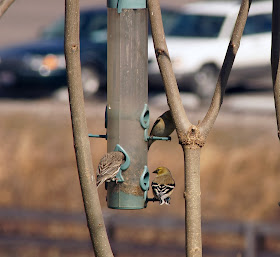Ash Cave is one of the Hocking Hills State Parks located in Hocking County Ohio. It's known for its geological formations and a spectacular waterfall. The Hocking Hills contain glacial remnant forests usually found much further north. The gorge is full of towering Tuliptree,
Liriodendron tulipifera, Eastern Hemlock,
Tsuga canadensis, Sycamore,
Platanus occidentalis, American Beech,
Fagus grandifolia, and Sugar Maple,
Acer saccharum. The rim is blanketed with Hemlock trees, and the upper slopes are a mix of Oak and Hickory. I've recorded 70 species of woody plants and nearly 100 spring wildflowers at Ash Cave.
Black and White Warbler
While working at the park back in 1980, I noticed a high number of
Northern Parula Warblers, Setophaga americana, and
Black-throated Green Warblers,
Setophaga virens. They weren't just passing through, but apparently nesting. These two species are few to absent in many of the other forest types in the surrounding counties, at least in the numbers found here. I wondered what other species might be present, so I decided to make a count of all the warblers found at Ash Cave.
Black-throated Green Warbler
Surveys were conducted in 1980 and again in 1981 between 7:00 and 9:00am. The route included the picnic area, gorge trail, rim trail, and part of the Buckeye trail behind the falls. Birds were recorded by both sight and song. Soon after the project I moved out of state, and never did anything with the data.
Canada Warbler
Years later I returned to the area and asked
Pat Quackenbush, naturalist for Old Man's Cave and surrounding parks, if he would like to participate in repeating the surveys. I wanted to see if the diversity had changed over the 25 years. We gathered data using the same methods as before. With both of us busy with other projects, we hem-hawed on what to do with the results. Before we knew it, another 5 years had passed. So in 2013, we did it again. Now we can compare over a 30 year period.
Common Yellowthroat
19 species of warblers were recorded over the five survey years. The most frequently encountered species include, Black-throated Green, Parula, Ovenbird, Louisiana Waterthrush, Yellow-throated, Black and White, Hooded, and Worm-eating.
Those that were occasional or uncommon were Pine, Yellow, Blue-winged, Blackburnian, Cerulean, Canada, Kentucky, Common Yellowthroat, Prothonotary, American Redstart, and Tennessee.
Hooded Warbler
The three most common species were Black-throated Green, Parula, and
Ovenbird, Seiurus aurocapillus. If we were to compare 1980-81 to 2005-06 & 2013, their numbers have declined by over 50%. The
Cerulean Warbler,
Setophaga cerulea, has gained a lot attention, showing the most rapid decline of all in North America. In 1980-81 there were 14 records. In 2005-06 we saw 2, and last year zero. Cerulean, like the
Kentucky Warbler, prefer broken canopies, and a multi-layered understory. With the maturity of Ash Cave forests, it may no longer be favorable to these species. (Jim McCormac personal comm.)
Kentucky Warbler
There were four birds in particular that showed the most drastic results.
Yellow-throated Warbler, Setophaga dominica, and
Kentucky Warbler,
Geothlypis formosa dropped by 93%.
Worm-eating Warbler,
Helmitheros vermivorum, by 90%, and
Hooded Warbler, Setophaga citrina, down by 85%. In S.E. Ohio, these are not rare warblers by any means, but at Ash Cave they are nearly nonexistent today.
Louisiana Waterthrush
Although I included a table at the end, the number of times we surveyed varied between the years, so comparing the total number of birds seen may be misleading. I think the best way to see the change is to average the
number of birds per visit.
1980-81=16.7
2005-06=6.6
2013=4.7
Of the original 19 species from 1980-81, only 7 were recorded this past year.
Ovenbird
So what's happening? Succession of the old fields on either side of the picnic areas have made the habitat unsuitable for species like Prairie, Blue-winged, Yellow Warbler, etc. The hardwoods in the canopy can survive for several hundred years, and the Hemlocks easily twice that. So the vegetation through most of the park, including the understory, has remained the same over the years in regards to the plant species. It may simply be the forest structure has changed.
Yellow Warbler
Why does the understory still have Ovenbirds and Waterthrushes, but not Worm-eating Warblers? If they forage throughout the woods, their behavior should not have been affected. Has there been too much soil compaction from off trail hiking? Perhaps visitation in the park has reached numbers that are uncomfortable for this species to nest on the ground here. The same could be asked of the Hooded Warbler, which also prefers understory. Surveys often end up asking more questions than they answer.
Prothonotary Warbler
Other causes include the deforestation of tropical sites these birds overwinter in. The increased number of windmills, cell phone towers, and building collisions take their toll during migration. The change in land use in our country. Increased Cowbird parasitism is another factor. Pesticides, destruction of wetlands and riparian zones, climate change, and cats! (Don't get me started on that one). The list goes on and on. It's probably not one cause, but a combination of factors.
Locally, another threat looms on the horizon. The
Hemlock Wooly Adelgid,
Adelges tsugae, a piercing sucking insect that has wreaked havoc on the hemlock trees of the Smoky Mountains. Though not yet at Ash Cave, it has been found in the Hocking Hills region. The loss of Eastern Hemlock from the park would surely cause an even more rapid decline of species diversity.
American Redstart
Pat and I have written this up for publication.
All warbler photographs courtesy of
Michael Williams.
































